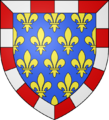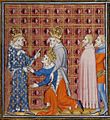Charles IV of France facts for kids
Quick facts for kids Charles IV |
|
|---|---|
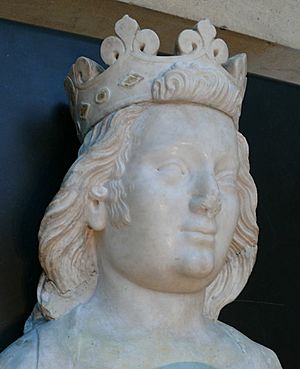
Gisant of Charles IV by Jean de Liège, c. 1372
|
|
| King of France (more...) | |
| Reign | 3 January 1322 – 1 February 1328 |
| Coronation | 21 February 1322 |
| Predecessor | Philip V |
| Successor | Philip VI |
| King of Navarre | |
| Reign | 3 January 1322 – 1 February 1328 |
| Predecessor | Philip II |
| Successor | Joan II |
| Born | 18/19 June 1294 Clermont, Oise, France |
| Died | 1 February 1328 (aged 33) Vincennes, France |
| Burial | Saint Denis Basilica |
| Spouse |
|
| Issue | Blanche, Duchess of Orléans |
| House | Capet |
| Father | Philip IV of France |
| Mother | Joan I of Navarre |
Charles IV (born June 18 or 19, 1294 – died February 1, 1328) was known as "the Fair" in France. In Navarre, he was called "the Bald." He was the last king from the direct line of the House of Capet. Charles ruled as King of France and King of Navarre (as Charles I) from 1322 to 1328. He was the third son of King Philip IV. Like his father, he was known for being handsome.
During his rule, Charles faced a peasant revolt in Flanders starting in 1323. In 1324, he tried to become the Holy Roman Emperor but was not successful. As Duke of Guyenne, King Edward II of England was a vassal (a ruler who owes loyalty) to Charles. However, Edward was slow to show his loyalty. Because of this, Charles took over the Duchy of Guyenne in a fight called the War of Saint-Sardos (1324). They later made a peace deal. Edward II agreed to be loyal to Charles and pay a fine. In return, Guyenne was given back to Edward, but it was much smaller.
When Charles IV died, he had no sons to take his place. This meant the main line of the House of Capet, which came from Philip IV, ended. His niece, Joan II, became queen in Navarre. In France, his cousin, Philip of Valois, became king. However, there was a disagreement over who should be the next French king. This dispute was between the Valois family (who were male descendants of Charles's grandfather Philip III of France) and the English kings (who were descendants of Charles's sister Isabella). This disagreement was a big reason for the start of the Hundred Years' War.
Contents
Who Was Charles IV?
Early Life and Royal Role
Charles became King of Navarre (as Charles I) because of his mother, Joan I of Navarre. Before becoming king, he was the Count of La Marche from 1314. He was crowned King of France in 1322 at the Reims Cathedral. Unlike his father, Philip IV, and his brother, Philip V, Charles was seen as a more traditional king. He was known for sticking to rules and defending his royal rights.

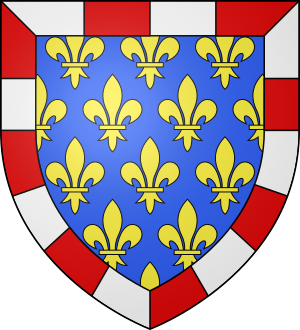
Charles's Marriages
Charles married his first wife, Blanche of Burgundy, in 1308. She was the daughter of Otto IV, Count of Burgundy. However, Blanche was involved in a scandal in 1314 and was put in prison. After Charles became king, he refused to let her go. Their marriage was ended, and Blanche went to live in a nunnery.
His second wife was Marie of Luxembourg. She was the daughter of Henry VII, the Holy Roman Emperor. Marie died after giving birth too early.
Charles married for a third time in 1325 to Jeanne d'Évreux. She was his first cousin, so they needed special permission from Pope John XXII to marry. Jeanne was crowned queen in 1326. Her coronation was a very grand and expensive event. The cost of food, furs, and jewels was so high that they were still discussing the bills years later. This ceremony was also the first time the famous medieval cook, Guillaume Tirel, appeared as a junior servant.
Key Advisors
During the first part of his reign, Charles relied a lot on his uncle, Charles of Valois. His uncle gave him advice and handled important military tasks. Charles of Valois was a powerful noble. He had also advised Louis X. He knew that if Charles died without sons, he and his male family members would have a strong claim to the throne.
What Charles IV Did as King
Changes at Home
Charles became king after a difficult time in southern France. Local nobles had resisted his older brother Philip V's plans for tax changes. Charles quickly took charge. He dealt with troublesome southern nobles and traveled through the region himself. Charles was well-educated and started a famous library at Fontainebleau.
During his six years as king, Charles's government became less popular. He changed the value of French money to benefit himself. He also sold government jobs, increased taxes, and took land from people he disliked. Charles was also involved in issues concerning Jewish people. His father, Philip IV, had taken property from many Jewish people in 1306. Charles worked hard to collect debts owed to these accounts.
Dealing with Other Countries
France and England
Charles inherited ongoing tensions between England and France. King Edward II of England, as Duke of Aquitaine, owed loyalty to the King of France. But he had avoided showing this loyalty to Charles's older brothers. When Charles became king, Edward tried to avoid it again. One problem area was Agenais, a border region. In 1323, a French noble built a fortified town called a bastide in Saint-Sardos, part of Agenais. Forces from Gascony (an English-held area) destroyed it. In response, Charles attacked Montpezat, which was held by the English.
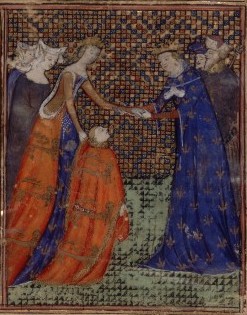
This led to the War of Saint-Sardos. Charles's trusted uncle, Charles, Count of Valois, took control of Aquitaine from the English. By 1324, Charles said that Edward's lands were lost and occupied almost all of Aquitaine.
Charles's sister, Isabella, was married to King Edward. She was sent to France in 1325 to make peace with her brother. Charles had told Pope John XXII he would return the lands if Edward gave up Agenais and showed loyalty for the rest. The Pope suggested Isabella as an ambassador. Charles welcomed Isabella to France. Later that year, Isabella was joined by her young son, Prince Edward. Prince Edward showed loyalty to Charles on behalf of his father as a sign of peace. But Charles still did not return all the lands in Aquitaine. They made a temporary agreement. Edward got back control of the remaining English areas in early 1326, while France kept the rest.
In 1326, Charles renewed an old alliance with Scotland called the Auld Alliance. This was done through the Treaty of Corbeil (1326).
Meanwhile, Isabella became close with an English noble named Roger Mortimer. She refused to go back to England. Instead, she went to Hainaut. There, she arranged for Prince Edward to marry Philippa, the daughter of the local Count. Isabella used money from Charles and other loans to gather an army. She invaded England and removed her husband, Edward II, from power. Edward II was later killed in 1327. Under Isabella's guidance, Edward III agreed to a peace treaty with Charles. Aquitaine would be returned to Edward. Charles would receive a large sum of money and control over several territories, leaving Edward with much less land.
Revolt in Flanders
Charles also faced problems in Flanders. The Count of Flanders ruled a very rich area that had always been quite independent from France. The French king was generally seen as having power over Flanders. However, this relationship had become difficult. Philip V had avoided fighting in Flanders. Instead, he allowed Louis to become count. Louis was largely under French influence, as he had grown up at the French court. But over time, Louis's strong loyalty to France and his lack of connections in Flanders made his position weak. In 1323, a peasant revolt led by Nicolaas Zannekin broke out. It threatened Louis's rule and even led to his imprisonment in Bruges.
At first, Charles was not very worried. The revolt could actually help the French crown by weakening the Count of Flanders. But by 1325, the situation got worse. The uprising meant Louis could not pay Charles the money he owed from earlier agreements. The size of the rebellion also threatened the feudal system in France itself. It might have looked like Charles was unable to help his vassal. So, France decided to get involved.
In November 1325, Charles declared the rebels guilty of treason and ordered them to be removed from the church. He also gathered an army. Louis pardoned the rebels and was released. But once he was safely back in Paris, he changed his mind. He promised Charles not to make a separate peace deal with the rebels. Even though Charles had gathered forces near the border, his attention was drawn to problems in Gascony. He eventually chose to end the rebellion peacefully through the Peace of Arques in 1326. Louis was only indirectly involved in this peace.
Charles and the Holy Roman Empire

Charles also influenced the life of his nephew, Holy Roman Emperor Charles IV. His nephew, originally named Wenceslaus, came to the French court in 1323 when he was seven. The French king took him under his care. Charles gave his nephew a very good education for that time. He also arranged his marriage to Blanche of Valois and even renamed him.
Charles and the Crusades
The crusades remained a popular idea in France during Charles's reign. His father, Philip IV, had planned a new crusade. His brother, Philip V, had almost started one in 1320. However, their plans were canceled. This led to a less organized movement called the Shepherds' Crusade (1320).
Charles asked Charles of Valois to talk with Pope John XXII about a new crusade. Charles of Valois was very interested in crusades and had even tried to become the Byzantine emperor earlier. But the talks did not go well. The Pope was worried that Charles IV might not use the money raised for a crusade for its true purpose. The conflict with England over Gascony also took over the negotiations.
After Charles of Valois died, Charles became more interested in helping the Byzantium. He committed to a crusade in 1326. Andronicus II of Byzantium sent a messenger to Paris in 1327. He suggested peace and talks about uniting the churches. A French messenger was sent back later that year. However, he found Byzantium in a civil war, and the talks failed. Charles's death the next year stopped any French help for Byzantium.
Charles IV's Death and What Happened Next
Charles IV died in 1328 at the Château de Vincennes. He was buried with his third wife, Jeanne d'Évreux, in Saint Denis Basilica. His heart was buried at the now-destroyed church of the Couvent des Jacobins in Paris.
Like his brothers before him, Charles died without any sons who survived him. This meant the direct line of the Capetian dynasty ended. Twelve years earlier, a rule had been recognized that women could not inherit the French throne. This rule, based on the Salic Law, meant Charles's one-year-old daughter Mary could not become queen. However, Jeanne was pregnant when Charles died. Since she might have a son, a temporary ruler was chosen. This was Philip of Valois, Charles's cousin. He was from the House of Valois, the next closest branch of the Capetian family.
Two months later, Jeanne gave birth to another daughter, Blanche. So, Philip became king and was crowned Philip VI in May. However, Edward III of England argued that while women could not inherit the throne directly, they could pass on the right to their sons. Under this idea, Edward III, who was the son of Queen Isabella (Charles's sister), believed he should have inherited the throne. This claim was a major cause of the Hundred Years' War (1337–1453).
Charles IV's Family
Charles married three times and had seven children who were legally recognized.
In 1308, he married Blanche of Burgundy. Their marriage ended in 1322. They had two children:
- Philip (born January 1314 – died March 1322)
- Joan (born 1315 – died May 17, 1321)
In 1322, Charles married Marie of Luxembourg. They had two children:
- Marie (born and died 1323)
- Louis (born and died March 1324)
On July 5, 1324, Charles married Joan of Évreux (1310–1371). They had three children:
- Jeanne (born May 1326 – died January 1327)
- Marie (born 1327 – died October 6, 1341)
- Blanche of France, Duchess of Orléans (born April 1, 1328 – died February 8, 1393). She married Philip, Duke of Orléans, who was the younger son of King Philip VI of France. They did not have any children.
Most of Charles's children died young. Only his youngest daughter, Blanche, lived to be an adult. Blanche was born two months after Charles died. During those two months, Charles's cousin Philip served as regent (temporary ruler). Once a girl was born, Philip became King Philip VI of France. He was the first French king from the House of Valois.
Charles IV in Stories
Charles is a character in Les Rois maudits (The Accursed Kings). This is a series of French historical novels by Maurice Druon. He was played by Gilles Béhat in the 1972 French TV show based on the books. He was also played by Aymeric Demarigny in the 2005 TV show.
Images for kids
-
Marriage of Charles IV and Marie of Luxembourg, by Jean Fouquet.
-
Charles's coat-of-arms from when he was Count of La Marche.
-
A drawing from that time showing the future Edward III showing loyalty to Charles IV. Edward's mother, Isabella, Charles's sister, is guiding him in 1325.
-
Charles gave his name to his nephew, Holy Roman Emperor Charles IV. Here, the nephew is showing loyalty to his patron.
See also
 In Spanish: Carlos IV de Francia para niños
In Spanish: Carlos IV de Francia para niños




